Problem
At a lemonade stand, each lemonade costs $5.
Customers are standing in a queue to buy from you, and order one at a time (in the order specified by bills).
Each customer will only buy one lemonade and pay with either a $5, $10, or $20 bill. You must provide the correct change to each customer, so that the net transaction is that the customer pays $5.
Note that you don’t have any change in hand at first.
Return true if and only if you can provide every customer with correct change.
Example 1:
Input: [5,5,5,10,20] Output: true Explanation: From the first 3 customers, we collect three $5 bills in order. From the fourth customer, we collect a $10 bill and give back a $5. From the fifth customer, we give a $10 bill and a $5 bill. Since all customers got correct change, we output true.
Example 2:
Input: [5,5,10] Output: true
Example 3:
Input: [10,10] Output: false
Example 4:
Input: [5,5,10,10,20] Output: false Explanation: From the first two customers in order, we collect two $5 bills. For the next two customers in order, we collect a $10 bill and give back a $5 bill. For the last customer, we can't give change of $15 back because we only have two $10 bills. Since not every customer received correct change, the answer is false.
Solution: Simulation + Greedy
Always use 10 bill first.
Time complexity: O(n)
Space complexity: O(1)
C++
|
1 2 3 4 5 6 7 8 9 10 11 12 13 14 15 16 17 18 19 20 21 22 23 24 25 26 27 28 |
// Author: Huahua // Running time: 18 ms class Solution { public: bool lemonadeChange(vector<int>& bills) { int fives = 0; int tens = 0; for (const int bill : bills) { if (bill == 5) { ++fives; } else if (bill == 10) { if (!fives) return false; ++tens; --fives; } else if (bill == 20) { if (tens && fives) { --tens; --fives; } else if (fives >= 3) { fives -= 3; } else { return false; } } } return true; } }; |
